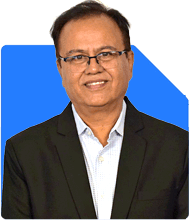Ramalingam Kalirajan |10893 Answers |Ask -Follow
Mutual Funds, Financial Planning Expert - Answered on May 27, 2024
He has an MBA in finance from the University of Madras and is a certified financial planner.
He is the director and chief financial planner at Holistic Investment, a Chennai-based firm that offers financial planning and wealth management advice.... more

Hello sir. I'm currently 32 with a monthly income of 90k. I invest 10k per month in PPF, and 22k per month in many different mutual funds (small amount SIP in each fund). Occasionally I invest in the share market. I have two loans of total 32k per month. My monthly expenses are around 20k. Can you provide a comprehensive plan so that by 60 I can have at least 1 crore in my name?
Achieving a financial goal of Rs. 1 crore by the age of 60 is attainable with disciplined savings and smart investments. Let's develop a comprehensive plan for you.
Current Financial Snapshot
Income and Expenses
Monthly Income: Rs. 90,000
Monthly Expenses: Rs. 20,000
Loans: Rs. 32,000 per month
Investments
PPF: Rs. 10,000 per month
Mutual Funds: Rs. 22,000 per month
Occasional Stock Market Investments
Assessing Your Investment Strategy
PPF Contributions
Benefits: PPF offers tax benefits under Section 80C and provides a safe, government-backed return.
Limitations: The returns are relatively lower compared to equity investments over the long term.
Mutual Fund Investments
Diversification: Investing in multiple mutual funds diversifies risk.
Potential for Growth: Equity mutual funds have the potential for higher returns compared to debt funds and PPF.
Regular SIPs: Systematic Investment Plans (SIPs) ensure disciplined investing.
Stock Market Investments
Opportunities: Direct stock investments can provide high returns if chosen wisely.
Risks: Stock market investments are volatile and require careful analysis.
Debt Management
Loan Repayment
Current EMI: Rs. 32,000 per month
Impact on Savings: Loan repayments reduce the amount available for investments.
Strategy: Focus on clearing high-interest loans first to free up funds for investing.
Setting Financial Goals
Target Amount: Rs. 1 crore by age 60
Investment Horizon: 28 years (from age 32 to 60)
Investment Plan to Achieve Rs. 1 Crore
Step 1: Continue with PPF Contributions
Annual Contribution: Rs. 1,20,000 (Rs. 10,000 per month)
Maturity: Continue investing in PPF for a stable, tax-free return.
Step 2: Optimize Mutual Fund Investments
Diversification: Ensure a mix of large-cap, mid-cap, and small-cap funds.
Review and Adjust: Periodically review the performance of your mutual funds.
Increase SIPs: Gradually increase your SIP amounts as your income grows.
Step 3: Maximize Equity Exposure
Long-Term Growth: Equities historically outperform other asset classes over the long term.
Fund Selection: Choose actively managed funds with a proven track record.
Regular Monitoring: Keep track of market trends and adjust your portfolio accordingly.
Step 4: Debt Reduction Strategy
Prioritize Loan Repayment: Aim to pay off high-interest loans first.
Increase Savings Post-Repayment: Redirect the amount saved from EMIs into investments.
Step 5: Emergency Fund
Safety Net: Maintain an emergency fund equivalent to 6 months' expenses.
Liquidity: Keep this fund in a liquid form like a savings account or short-term debt fund.
Detailed Monthly Investment Plan
Assumptions
PPF Returns: Approximately 7% per annum (subject to change as per government regulations)
Equity Mutual Fund Returns: Approximately 12% per annum (considering historical performance)
Investment Period: 28 years
Monthly Investment Allocation
PPF: Rs. 10,000
Mutual Funds: Rs. 22,000
Additional Investments: Any surplus funds post-loan repayment to be directed into mutual funds or stocks.
Expected Growth of Investments
PPF Growth
Monthly Contribution: Rs. 10,000
Expected Maturity Value: Approximately Rs. 1 crore (considering continuous contributions and compounding)
Mutual Fund Growth
Monthly SIPs: Rs. 22,000
Expected Maturity Value: Approximately Rs. 3 crore (considering continuous SIPs and compounding at 12%)
Achieving the Target
By maintaining consistent investments in PPF and mutual funds, and optimizing your portfolio, you can comfortably achieve your financial goal of Rs. 1 crore and potentially much more. Here are the key steps:
Discipline and Consistency: Continue with disciplined SIPs and PPF contributions.
Debt Management: Focus on clearing high-interest loans to increase available funds for investment.
Portfolio Review: Regularly review and rebalance your investment portfolio.
Increase Investments: Gradually increase your SIP amounts as your income grows and loans are repaid.
Professional Guidance: Consult a Certified Financial Planner to tailor your investment strategy and make informed decisions.
Conclusion
Reaching a target of Rs. 1 crore by age 60 is achievable with disciplined investing and smart financial planning. By continuing your PPF contributions, optimizing your mutual fund investments, managing debt efficiently, and regularly reviewing your portfolio, you can secure a financially stable future.
Best Regards,
K. Ramalingam, MBA, CFP,
Chief Financial Planner,
www.holisticinvestment.in
You may like to see similar questions and answers below
Ramalingam Kalirajan |10893 Answers |Ask -Follow
Mutual Funds, Financial Planning Expert - Answered on Jun 11, 2024
Ramalingam Kalirajan |10893 Answers |Ask -Follow
Mutual Funds, Financial Planning Expert - Answered on Jun 21, 2024
Ramalingam Kalirajan |10893 Answers |Ask -Follow
Mutual Funds, Financial Planning Expert - Answered on Dec 23, 2024
Sunil Lala | Answer |Ask -Follow
Financial Planner - Answered on Jul 17, 2025
Ramalingam Kalirajan |10893 Answers |Ask -Follow
Mutual Funds, Financial Planning Expert - Answered on Dec 15, 2025
Ramalingam Kalirajan |10893 Answers |Ask -Follow
Mutual Funds, Financial Planning Expert - Answered on Dec 15, 2025
Radheshyam Zanwar |6746 Answers |Ask -Follow
MHT-CET, IIT-JEE, NEET-UG Expert - Answered on Dec 15, 2025
Ramalingam Kalirajan |10893 Answers |Ask -Follow
Mutual Funds, Financial Planning Expert - Answered on Dec 15, 2025
Ramalingam Kalirajan |10893 Answers |Ask -Follow
Mutual Funds, Financial Planning Expert - Answered on Dec 15, 2025
Ramalingam Kalirajan |10893 Answers |Ask -Follow
Mutual Funds, Financial Planning Expert - Answered on Dec 15, 2025
Samraat Jadhav |2508 Answers |Ask -Follow
Stock Market Expert - Answered on Dec 15, 2025
Ramalingam Kalirajan |10893 Answers |Ask -Follow
Mutual Funds, Financial Planning Expert - Answered on Dec 15, 2025
Reetika Sharma |425 Answers |Ask -Follow
Financial Planner, MF and Insurance Expert - Answered on Dec 15, 2025
Radheshyam Zanwar |6746 Answers |Ask -Follow
MHT-CET, IIT-JEE, NEET-UG Expert - Answered on Dec 15, 2025
























